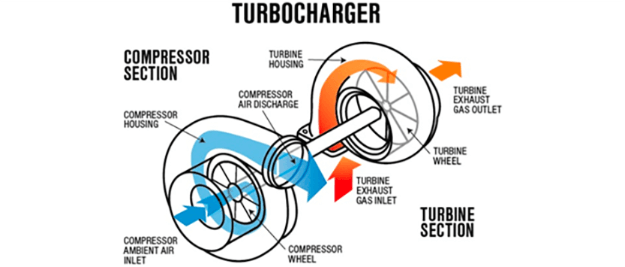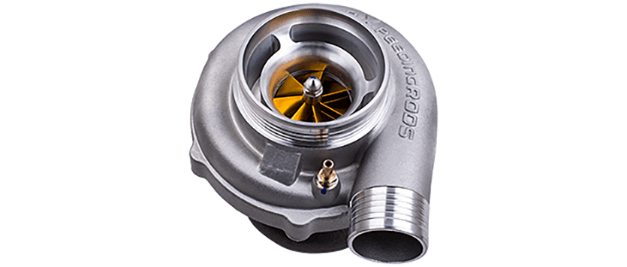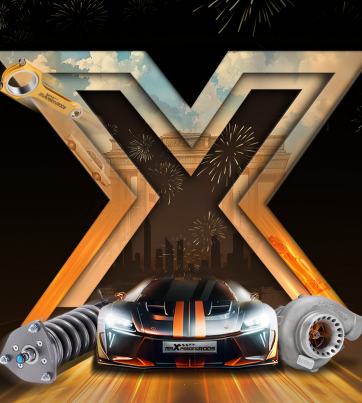WHAT IS A TURBOCHARGER?
A turbocharger(turbo)is a turbine-driven forced induction device that increases an internal combustion engine's efficiency and power output by forcing extra air into the combustion chamber. When a turbocharger brings more air into the chamber, it gets mixed with more fuel, yielding more power as a result. In reality, the turbo doesn't really get “extra air” into the engine, it actually compresses the air, which means there are more molecules being packed into the same space.

HOW DOES A TURBOCHARGER WORK?
The most basic observation we can make about a turbocharger is that it can be split into the hot and cold side. The hot side houses the turbine wheel and the cold side houses the compressor wheel. All turbos are connected to the engine on their hot side. As your engine is running it creates exhaust gasses, these exhaust gasses would otherwise be wasted, but on a turbocharged engine, these hot and fast-moving gasses are used to drive the turbine wheel. On the other side, the cold side, we have the compressor wheel. The compressor wheel has a fixed connection to the turbine wheel via a common shaft. When you spin the turbine wheel, you also spin the compressor wheel. The compressor wheel shape is designed to suck in air into the turbocharger. It's called the compressor wheel because other than sucking the air in, the compressor wheel plays an important part in compressing the air, after which it sends the air through the compressor housing into your engine intake manifold and your combustion chamber. This compression of air is what helps turbocharged engines make more power.
HOW TO BUY A TURBOCHARGER?
Correctly identifying the turbo means you'll get the right replacement first time, saving you time, money, and hassle. In order to supply the correct turbo for your vehicle, we will always ask you for your vehicle make, model and year, or to supply the part number from the Turbocharger either directly from the Turbocharger itself or by contacting your vehicle dealer to get the OEM part number from them. If you are looking to turbocharge a previously naturally aspirated vehicle then you will have to choose a turbocharger that best fits your engine size, bore, stroke, number of cylinders, desired power and torque levels, etc.
You can contact one of our turbo specialists through our website for further assistance on choosing the right turbocharger for your application.

WHY BUY TURBOCHARGERS AT MAXPEEDINGRODS?
MaXpeedingRods has been engaged in the research and development of high-quality turbochargers for decades. We offer turbochargers at affordable prices, made from high-quality materials and components to ensure desired performance and durability. All our turbocharger housings are accurately cast and all cartridges are fully balanced to ensure a perfect fit and long-lasting boost. All our turbochargers also come with bolting hardware and gaskets needed to bolt them onto your exhaust manifold.
Our street performance turbochargers feature a high nickel alloy shell with a temperature resistance of up to 850 degrees C. They feature high-quality journal bearings and benefit from high precision dynamic balancing. High precision cast aluminum compressor and turbine wheels ensure optimized spool-up and ensure reliable performance in the 200-600 horsepower range.
Our sport performance turbochargers take things a step further with a stainless steel volute that increases temperature resistance to 1050 degrees C. CNC machined aluminum compressor and turbine wheels ensure greater durability and are able to cope with extremely high boost pressures and RPMs. A stronger bearing structure with improved thrust bearings ensures that our sport performance turbos can support boost pressures of up to 3.0 bar and horsepower ranges of 300-850 hp.
WHAT ARE THE SIGNS THAT MY CAR NEEDS NEW TURBOCHARGER?
Turbos usually last a long time, but like most automotive components they do have a certain lifespan and will eventually fail. A turbo has to survive extreme temperatures and incredible rpms (up to 300.000 rpms) so it's no wonder it can't last forever. Here are 5 signs that often point to a turbo that's about to give up the ghost.
1. Slow AccelerationThe primary function of a turbo is to make your car more powerful. One of the first noticeable symptoms is lack of power and slow acceleration. If you notice that your car doesn't accelerate as fast as it used to, one of the first things you should consider checking is the turbo.
2. Burning OilBurning excessive amounts of oil is typically a sign of a turbo failure. Locate the downpipe, at the front of the turbo, and disconnect it. You can look inside the turbine by using an endoscope; if there is a significant amount of oil inside, that's a sign of gradual failure. You should resolve the problem as soon as possible; if left untreated, your turbo might experience a catastrophic failure, which could result in engine damage.
3. Excessive Exhaust SmokeIf the turbo housing cracks and/or if there are worn internal seals, this may lead to oil leaking into your exhaust. As the oil burns off you will see a distinct grey smoke and oil burning smell coming from your exhaust. So if you notice smoke when you rev your engine, it could be a sign of a faulty turbo. But be warned, oil burning can also come from an engine with high mileage and worn valve stem seals and/or worn piston rings.
4. Check Engine Light or CELOn most modern cars, the computer diagnostics will detect turbo issues (such as lacking or excessive boost pressure, oil in the exhaust, etc.) and display a “check engine” light. With that said, the CEL is displayed for a number of problems, sometimes it warns us of a loose gas cap and sometimes about far more serious issues. One of those more serious issues could be the turbo. It's best to use a diagnostic tool to check what the CEL code is exactly.
5. Loud Whining NoiseWhen boost is running, a failing turbo could make a loud whining noise. The noise usually sounds like an ambulance or police siren, and it tends to get louder as the problem aggravates. If you notice an unusual noise paired with some of the above symptoms, your turbo is likely failing. When a turbo becomes faulty, there are plenty of warning signs. They are often audible or they offer visual queues. Ensure at each servicing that you have your oil changed to avoid carbon deposits. If your turbo is older, consider having it replaced. If you aren't experienced with vehicle components, have a licensed mechanic diagnose the problem.
HOW TO INSTALL A TURBOCHARGER IN A CAR?
Have you ever wanted to know how to install a turbocharger, but the task seems too daunting? Let expert mechanics at MaXpeedingRods help with this step by step guide and help you on your DIY turbo removal and install project.
Step1: Make sure that the turbo is cool to the touch before working on it. Turbos get extremely hot and can easily burn you.
Step2: Unbolt and remove air filter housings and associated turbo intake hoses and/or pipes
Step3: Disconnect and remove any electrical connections (if present) to the turbo. Modern turbos often have electrical wastegates that are connected to the vehicle's wiring harness. Older turbos might not have any electrical connections going to the turbocharger
Step4: Remove and disconnect and hoses or pipes that connect the turbo to the intercooler.
Step5: Disconnect turbo oil delivery and return lines. Have a shop rag ready to prevent large oil spills and messes.
Step6: If the turbo is also water-cooled, disconnect coolant delivery and return lines from the turbo. Again, have a shop rag ready.
Step7: Unbolt and disconnect the downpipe from the turbocharger. Safely hang and secure the downpipe or separate it from the exhaust system and remove it completely.
Step8: Depending on access and space in your engine bay you can either remove the turbo from the exhaust manifold or remove the turbo and manifold together as a single unit and then unbolt the turbo from the manifold once they're both out of the engine bay.
Installation is the opposite of removal. Make sure to protect the new turbo during the install to prevent any debris or foreign matter falling into the compressor housing. If you are reinstalling a water-cooled turbo make sure to check if your coolant system needs bleeding. Once everything is installed double-check all hose, pipe and line connections to ensure everything is properly installed. Start the engine and watch for signs of oil leakage at the turbo/manifold and oil line connections. If none exists, drive the vehicle a short distance to fully warm the engine and then re-inspect. Investigate any unusual noise or condition. If all checks out, then there is no further break-in necessary and the vehicle can be driven as usual.







